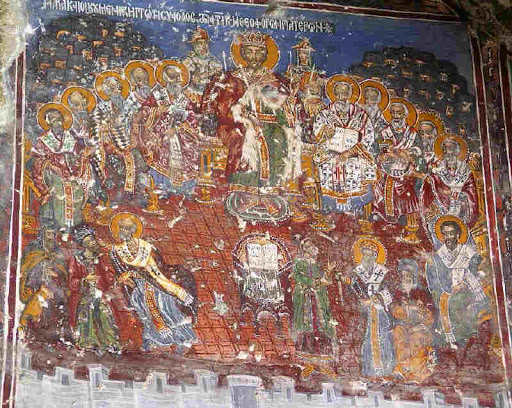Breastfed with the pure Orthodox faith, Wulfila bishop of the Goths (student of Ep. Sophilus Gothic, participant in the First Ecumenical Council) accepted the personal invitation of Emperor Theodosius I to participate in the Second Ecumenical Council in Constantinople and certainly took an active part in the initial synodal sessions, contributing at least to the editing of the fundamental first two canons aimed at establishing religious peace in both the empire and the church. Indicative is the fact that the emperor issued a special law after the end of the council meetings, which authorized special powers of attorney of pure Orthodoxy in a number of areas, among which we find the names of some of the probable allies and sympathizers of the “Gothic apostle” (“Terentius of Scythia and Martyr of Marcianopolis in Moesia and Scythia”) who accompanied him to the Ecumenical Forum of Constantinople, otherwise we could hardly explain the presence them there at a certain historical moment, and it is very possible that they sent him after his death before the end of the Ecumenical Council. Moreover, they come from dioceses where Latin Arianist authors work on the heritage of Wulfila – – Dorostol, Ratiaria, Nove, Markianopol, Nikopolis ad Istrum. Thanks to Auxentius of Durostorum, the Creed of his teacher, Bishop Wulfila, was passed on to us:
“I, Wulfila, Bishop and Confessor, have always believed thus and in this sole and true faith I make my journey to my Lord,
I believe that there is only one God the Father, alone unbegotten and invisible, and in His only-begotten Son, our Lord and God, creator and maker of all things, not having any like unto Him. Therefore there is one God of all, who is also God of our God, And I believe in one Holy Spirit, an enlightening and sanctifying power. As Christ says after the resurrection to his Apostles: “Behold I send the promise of my Father upon you; but tarry ye in the city of Jerusalem until ye be clothed with power from on high.” (Luke 24.49) And again: “And ye shall receive power coming upon you by the Holy Spirit.” (Acts 1.8) Neither God nor Lord, but the faithful minister of Christ; not equal, but subject and obedient in all things to the Son. And I believe the Son to be subject and obedient in all things to God the Father.”
The imperial law ends as follows: “All who are not in agreement with the said bishops must be expelled from the church in order to ever receive episcopal authority in it.” (Codex Theodos., Tit. De fide catholica, lex III; cf. Socrat, Hist. Eccl. V, 8, et Valesii, Annot. In. Cap. Cit. Socratis, – Migne, sg, t. 67, col. 576-581). The migration of the “little Goths” of Woolfila is indicated in 344 and 348, the latter being more probable according to more and more researchers. It seems very plausible to assume that Woolfila did arrive in 344 from the Danube, but it would have been to take part in the Ecumenical Council convened in 343 by the Western and Eastern emperors in Serdica, and its delay of several months was due to of the complicated situation at home, due to the persecutions against the Christianized Goths and personally against him by the pagan Gothic princes. Upon his arrival, he found that the Ecumenical Council had been compromised and failed after being constituted by the Eastern group of bishops at the counter-council in Philippopolis. Even if he did not arrive at the end of the council sessions, he at least came across the representation of the Eastern Party at the court of Constantius II on Easter. The Archbishop of Gothia received his appointment with the favor of the royal father (the Great Constantine), the emperor of the Eastern Roman Empire, and presented to him the question of the migration from the Danube to Moesia to the Kherson Gothic Christians, whose spiritual and secular leader he was. The latter was completed in 348. The fate of his people was entirely in the hands of the Arian emperor, so that the Gothic hierarch adopted the position expressed in the Encyclical of the Bishops of the East, met in Philippopolis the same year, among the pre-Nicene Conservatives and the moderate Arians, who enjoyed it with the benevolence of imperial state power and religious policy. This orientation later led to the emergence of Gothic Arianism. In addition to the above, Wulfila was ordained a bishop with the heresiarch of the moderate Arians, Ep. Eusebius of Nicomedia (close to Emperor Constantine I, a classmate of Arius himself and leader of the Eusebian Semi-Arian Party.
CHRONOLOGICAL TABLE OF THE COUNCILS – IV CENTURY
325 Council of Nicaea (I Ecumenical).
330 Council of Antioch. Council of Tire-Jerusalem.
340 Council of Rome.
341 Council of Sanctification in Antioch.
343 Council of Serdica and Counter-council of Philippopolis.
346 Cologne Council.
351 I Council of Sirmium.
353 Council of Arles (dominated by the Arians).
355 Council in Milan /Milan/.
356 Council of Béziers.
357 II Council of Sirmium.
358 Omius Council in Ancyra. III Council in Sirmium. Council of Antioch.
359 Fair in Seleucia-Rimini.
360 Council of Constantinople.
361 Council of Paris /the bishops of Gaul are in the position of Nicaea/.
362 Council of Alexandria.
381 Council of Constantinople (II Ecumenical).









